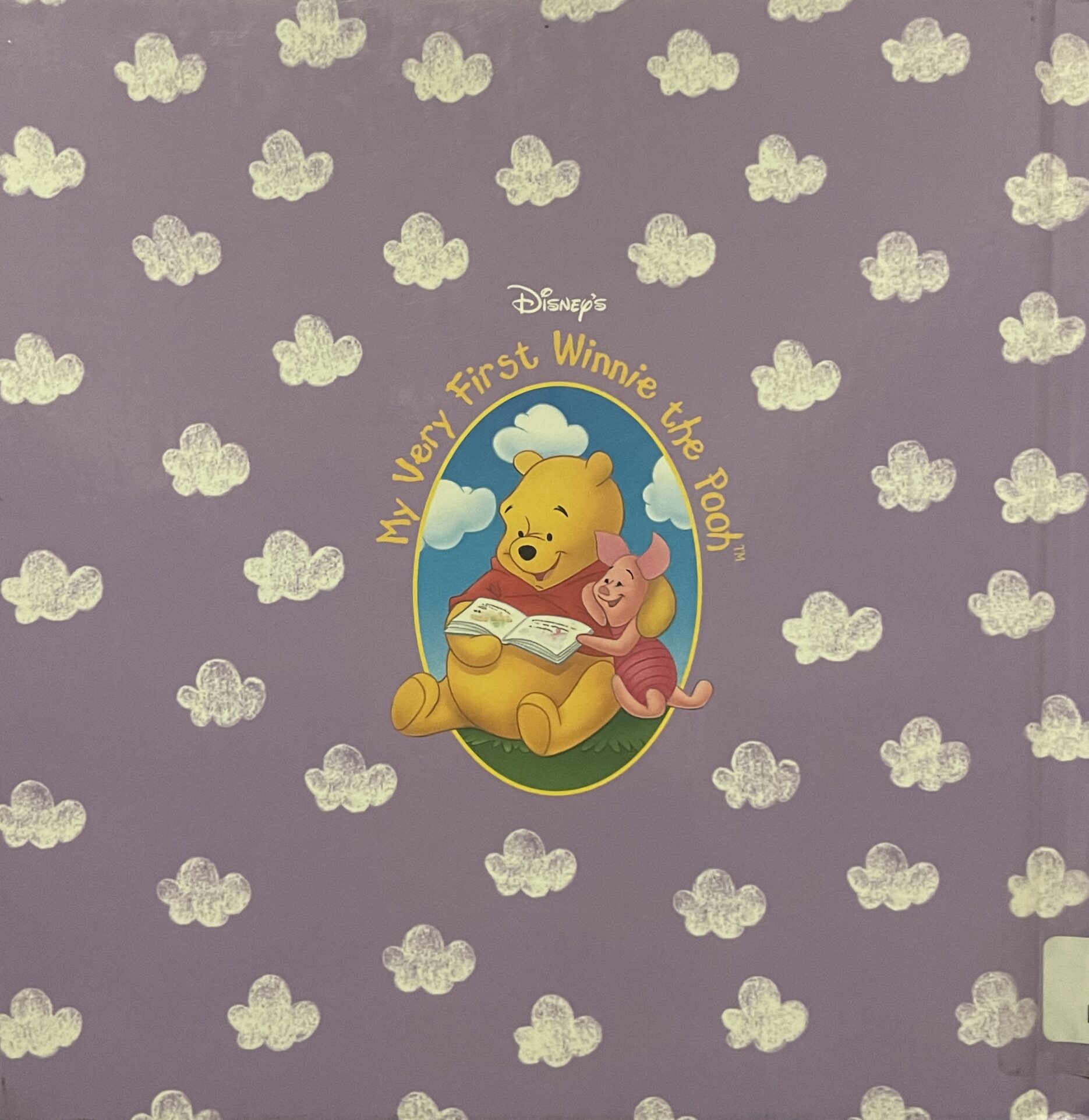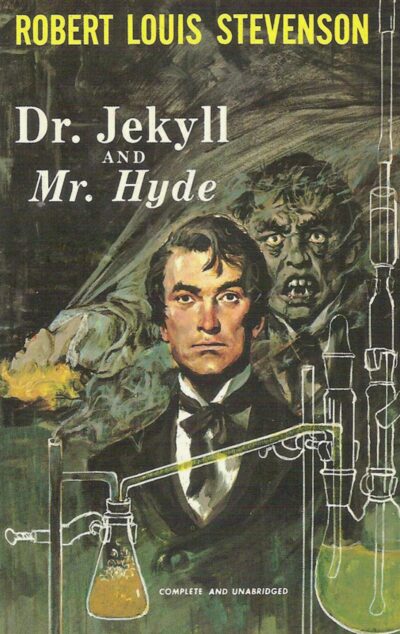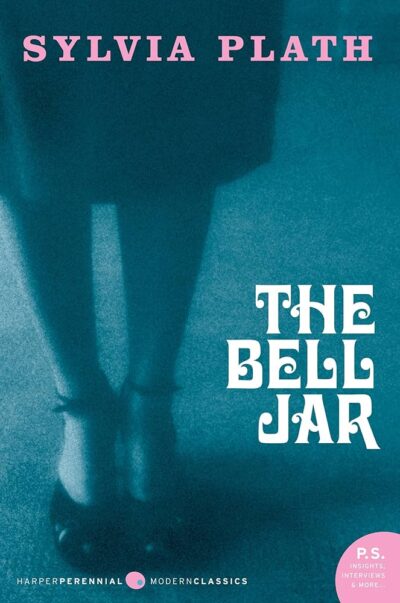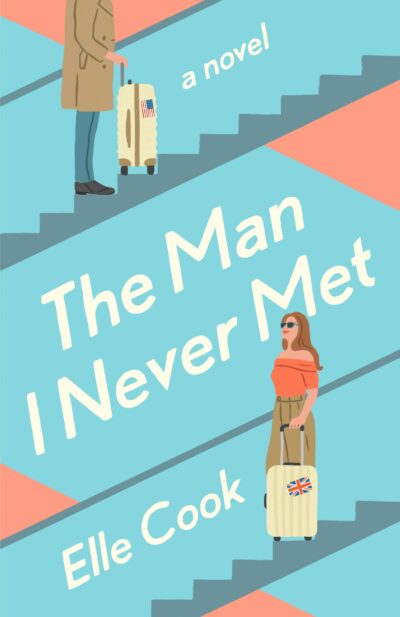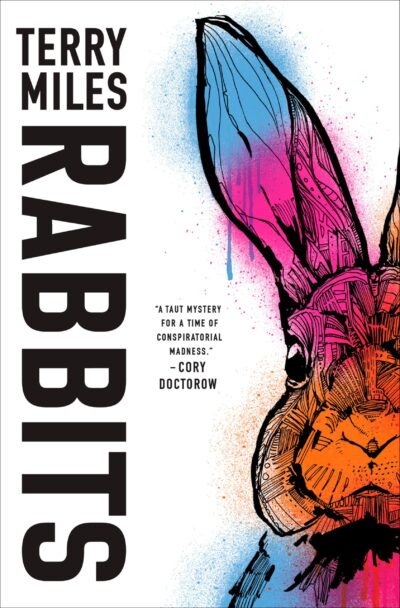Why Winnie? 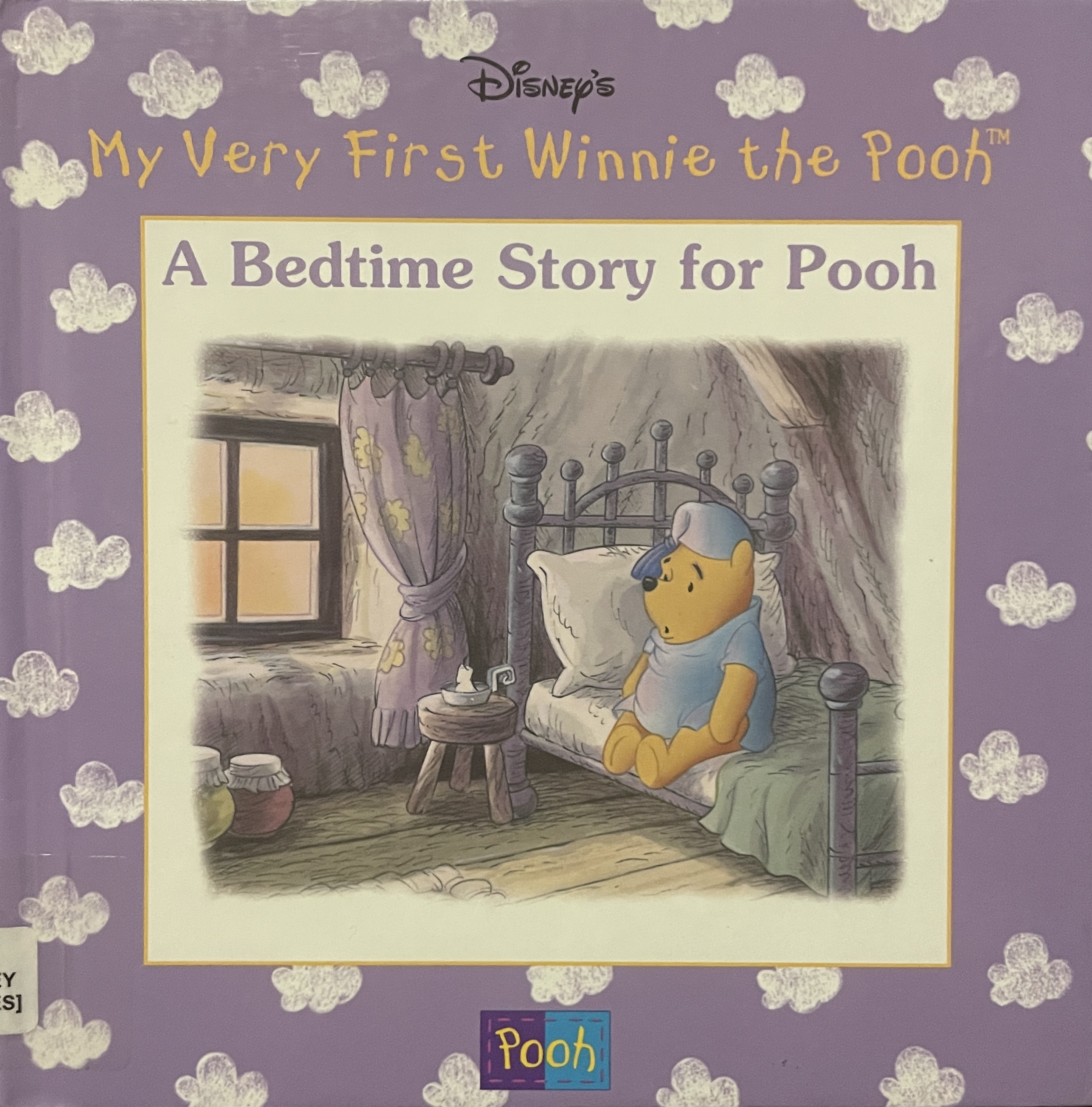
You might be wondering why I chose a children’s book for an honors English + Psychology course assignment examining sophisticated literary techniques and meaningful experiences. Well, I do not think that there could have been a better choice for said assignment. Children, while maybe unexpected, consume substantial literature- particularly around bedtime. While some kids are, of course, too young to comprehend and retain what they are read, as children grow older they begin to learn about the world and one way that they gather information is through the books they are read or later choose to read. Most children’s books are parables, holding some sort of simple moral lesson for the children to consume. Given that this is a sensitive period in human life, is this not the most interesting area to examine for the effects of story on the brain?
So, why Winnie the Pooh of all children’s books? Well, this story is iconic, present in many households and mass produced in various renditions. Not to mention that the graphics are adorable and entertaining. I personally haven no memory of ever watching or reading Winnie the Pooh, so I thought that this would be a nice excuse. My interest in the story comes from Eeyore, a character well known to represent depression. Many individuals voice identifying with Eeyore and that, despite being a children’s character, Eeyore is very well portrayed in terms of realism. How does seeing a chronically sad character affect a child’s growing brain? Further, is the fact that this behavior is accepted meaningful for a child’s later cognitive development? Let’s see how I experience the story as an adult.
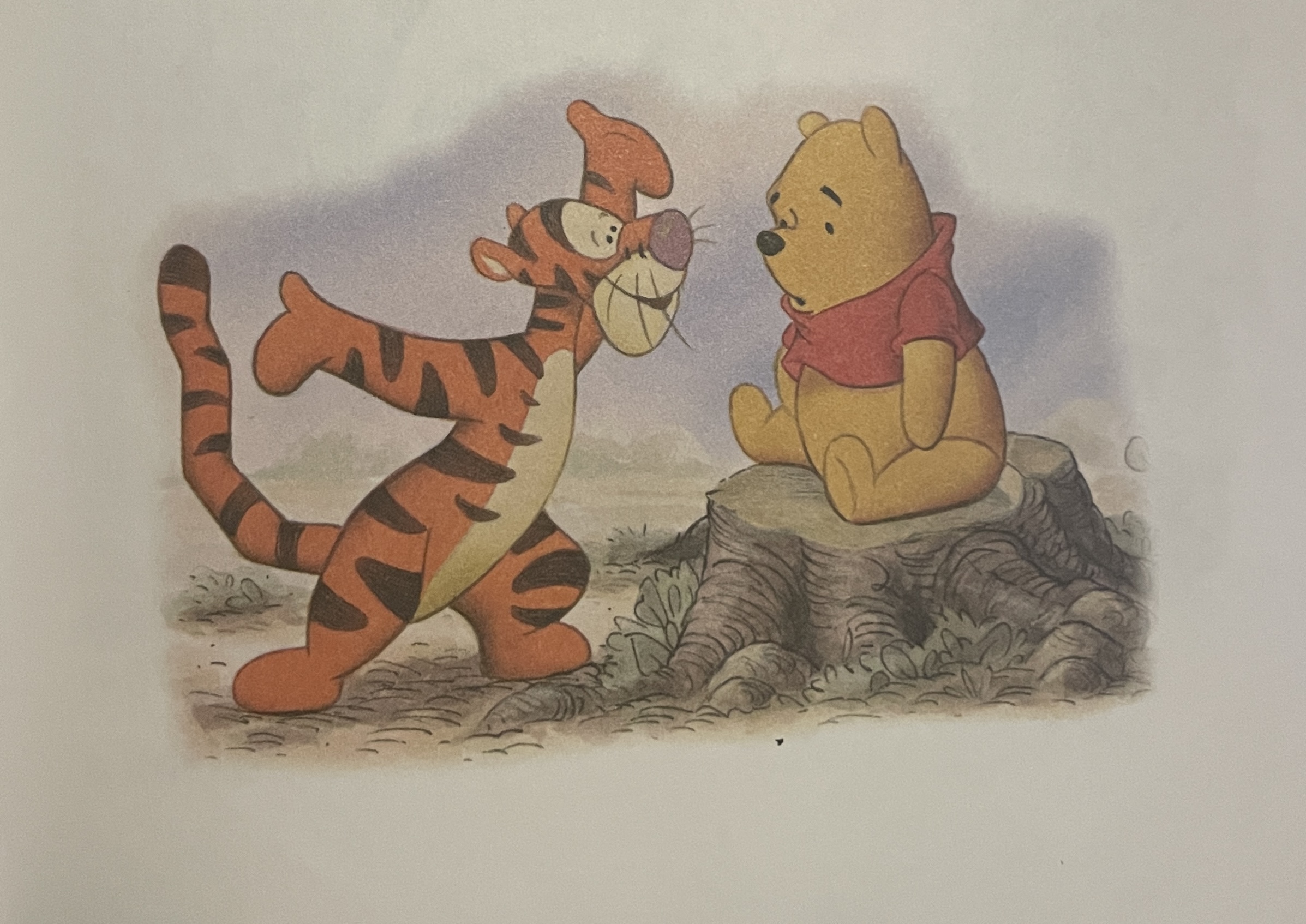 Describing my Experience
Describing my Experience
For this assignment I will be reading four Winnie the Pooh books due to their brevity and simple diction. So far I have read “Rainbow Colors” and “A Bedtime Story for Pooh”, two newer Winnie the Pooh books published by Disney. Each was a short picture book that presented a conundrum that needed solving by the Winnie the Pooh crew. While reading these books I experienced some awe for the effort and thought put into the illustrations and plot. While I was relearning the lessons and values presented in the books, this did not minimize my sober uplift upon finishing each story. I am thrilled with my choice for this post and am thoroughly enjoying my time reading these books as well as identifying technologies that pair with experiences I have gained.
In “Rainbow Colors” the Winnie the Pooh crew sees a rainbow, but Owl missed it. Once Owl finds out that he missed the rainbow, he appears dejected. In response, the rest of the Winnie the Pooh crew decides to make a rainbow for Owl to see so that he could be cheerful and included. Each member of the Winnie the Pooh crew set off to find an item corresponding to the colors of the rainbow. The book places emphasis on how color is all around us, filling the world through nature alone. This plot points out how sometimes people fail to notice their surroundings, forgetting to take a moment to appreciate the little things. Further, it teaches values of friendship and inclusion, promoting thoughtfulness, caring, consideration, and more.
“A Bedtime Story for Pooh” follows Winnie the Pooh on his adventure to go to sleep. Winnie the Pooh was unable to sleep for a whole night! When realizing he was hungry, Winnie the Pooh did not know what to do because he is not meant to eat breakfast before going to bed. As such, Winnie the Pooh embarks on an adventure, seeking a bedtime story so that he can sleep and then eat. Winnie the Pooh ventures through the entire neighborhood (forest?), speaking to each member of the Winnie the Pooh crew before he finally falls asleep. The Winnie the Pooh crew then sets up a substantial breakfast feast for when Winnie the Pooh wakes up. This story emphasizes the importance of both sleep and breakfast as well as having friends/family that take care of you. While this story was designed to put children to bed, it also provides lessons on trust, reliance, healthy relationships, and more.
I have now read two additional Winnie the Pooh books “Winnie the Pooh and The Missing Pots” and “Tigger Tales”. In reading these books I had many of the same experiences as with the previous two books due to similarities in employed technologies. I similarly experienced empathy, double identification, sober uplift, and tranquility. I did, however, have two new experiences in being wrong and some mild existential nausea– two experiences I did not expect with this genre of literature. Overall, I definitely preferred the first two books over the second two for a variety of reasons.
 “Winnie the Pooh and The Missing Pots”
“Winnie the Pooh and The Missing Pots”
This story is another newer Winnie the Pooh book published by Disney, following Tigger and Roo through a mystery after they lose old pots they were meant to throw out for Kanga. Embarking on a journey to find the pots, Tigger and Roo are under the impression they had no success despite finding every pot. Tigger and Roo did not recognize the pots as they had all gained a new purpose thanks to their new owners. The rest of the Winnie the Pooh crew had each adopted an old pot and put it to use to fulfill their respective needs, teaching the reader (and Tigger and Roo) the concept and importance of recycling.
“Tigger Tales” 
This book features three different stories written by the original Winnie the Pooh author A. A. Milne and art true to the original illustrations. Through this book I experienced being wrong as I expected to enjoy the original writing and illustration styles more than the newer ones, but found myself highly disappointed with “Tigger Tales”. The first story is titled “Tigger Comes to the Forest and Has Breakfast” and depicts Pooh’s first time meeting Tigger. Tigger is mildly neandrathalic, being highly unaware of Pooh’s (human-adjacent) customs. Despite the challenges Tigger poses, Pooh and his friends are highly patient and helpful, teaching the reader values of patience. The second story “It Is Shown That Tiggers Don’t Climb Trees” follows Tigger and Roo up a tree, but Tigger gets too scared to go back down. It is difficult to say what the purpose of this story was, I found it to be highly uncaptivating, but I believe it is meant to teach small children the importance of caution and admitting when one is not capable of doing something. The final story “Tigger Is Unbounced” similarly left me wishing for something more meaningful, or at least amusing. The story goes through the Winnie the Pooh crew’s complaints about Tigger’s bouncing, but ends with Tigger saving the day. I would imagine that this is meant to reassure children that even if something about them might be annoying to others, it can be beneficial or meaningful in some way and it is important not to judge or take something away from someone else.
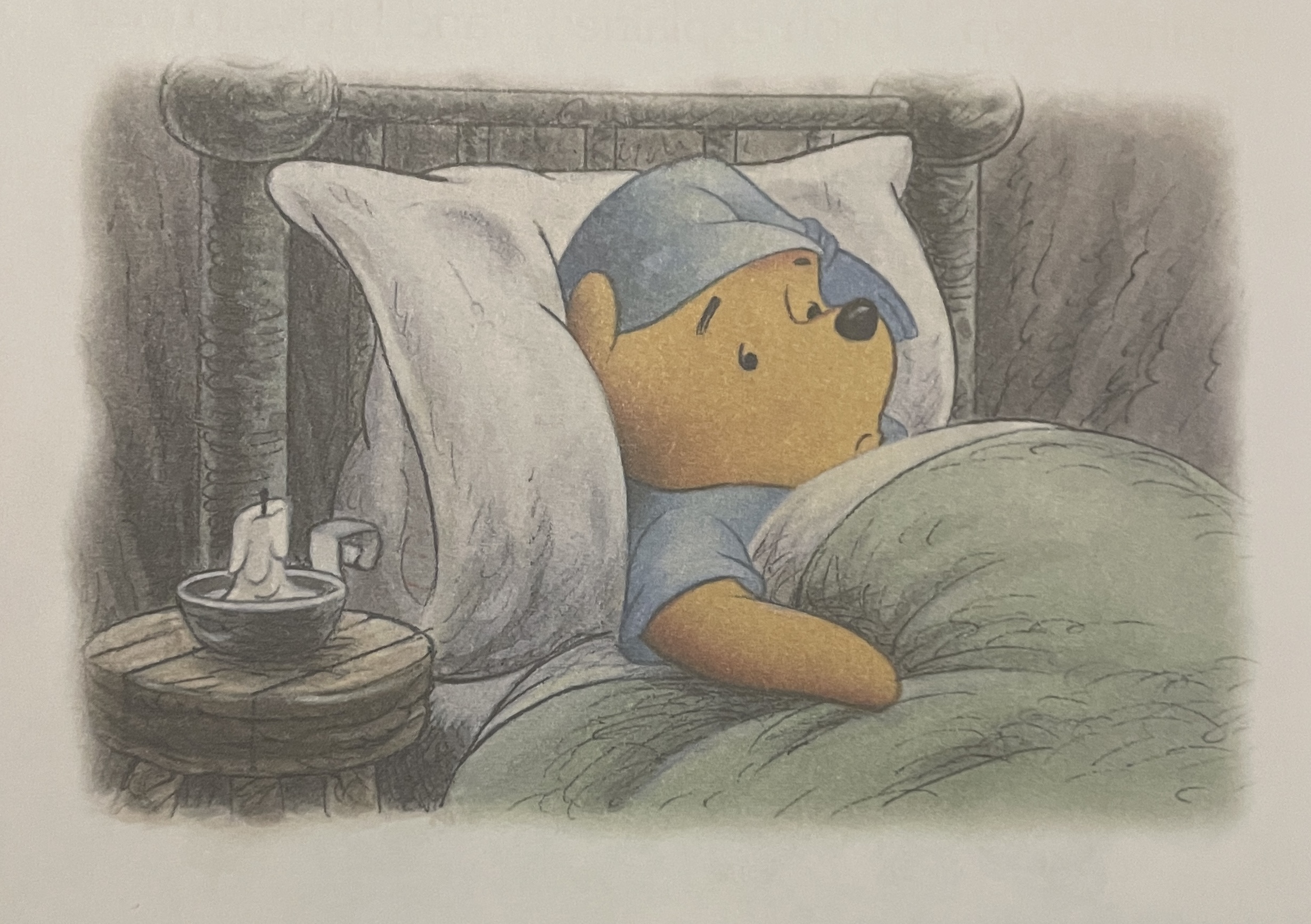 Classifying my Experience
Classifying my Experience
All of these books, while different in the lesson and values they teach, prompted similar experiences. In every story that I read I experienced a certain tranquility, knowing that it would all work out in the end and that this would not involve any stress or distress. Given the nature of these books as being written and illustrated for children, it is not surprising to note that I experienced some wonder. While children may experience wonder from learning things they did not previously know, I was able to experience it in tandem with relearning lessons and values that I am already thoroughly familiar with. These books, to me, are a gift of beautiful lessons wrapped in colorful and adorable illustrations, a small miracle for children that fosters some astonishment. I could not help but wonder “what if?”, experiencing mind wandering regarding how life could be for children who have polite books like this versus kids who are not given the luxurious gift of such neatly, kindly packaged gifts.
Thanks to the delightful experience and relatable material, I felt a connection to the Winnie the Pooh crew. I quickly grew fond of the little community the stories feature. Through Eeyore specifically I was able to go through a plethora of different experiences. At first I felt empathy toward Eeyore, recognizing his sadness and difficulty going through life. It seemed that everyone and everything around him was so happy, but that he could not relish in such joy. I experienced double identification as Eeyore began worrying about the perceptions of those around him, being self conscious and over thinking situations. However, the Winnie the Pooh crew accepted Eeyore for who he was and how he acted, not demanding anything more from him or attempting to change him. This inspired both generous love as well as self-acceptance as society often faults individuals for appearing sad or dealing with more negative emotions. For example, being a pessimist is often frowned upon, but not for Eeyore and not by the Winnie the Pooh crew. While I do my best to love everyone generously, these extremely positive stories inspire me to remember that I am ready to grow and that there is always room to do so.
As I went on to read two more books, I furthered my experiences of double identification with and empathy for Eeyore, experiencing some existential nausea in tandem with his pessimism. Despite these more difficult and negative experiences, I still experienced the same tranquility thanks to knowing that everything would end positively. The “Winnie the Pooh and The Missing Pots” book provided me with the same sober uplift, but the “Tigger Tales” stories fell short, leaving me more confused than joyful. This shift in enjoyment to disappointment left me facing the fact that I was wrong in my expectations and did not enjoy all Winnie the Pooh books, likely having a preference for the new style of writing and illustration in comparison to the original works of A. A. Milne.
Features that Prompted my Experience 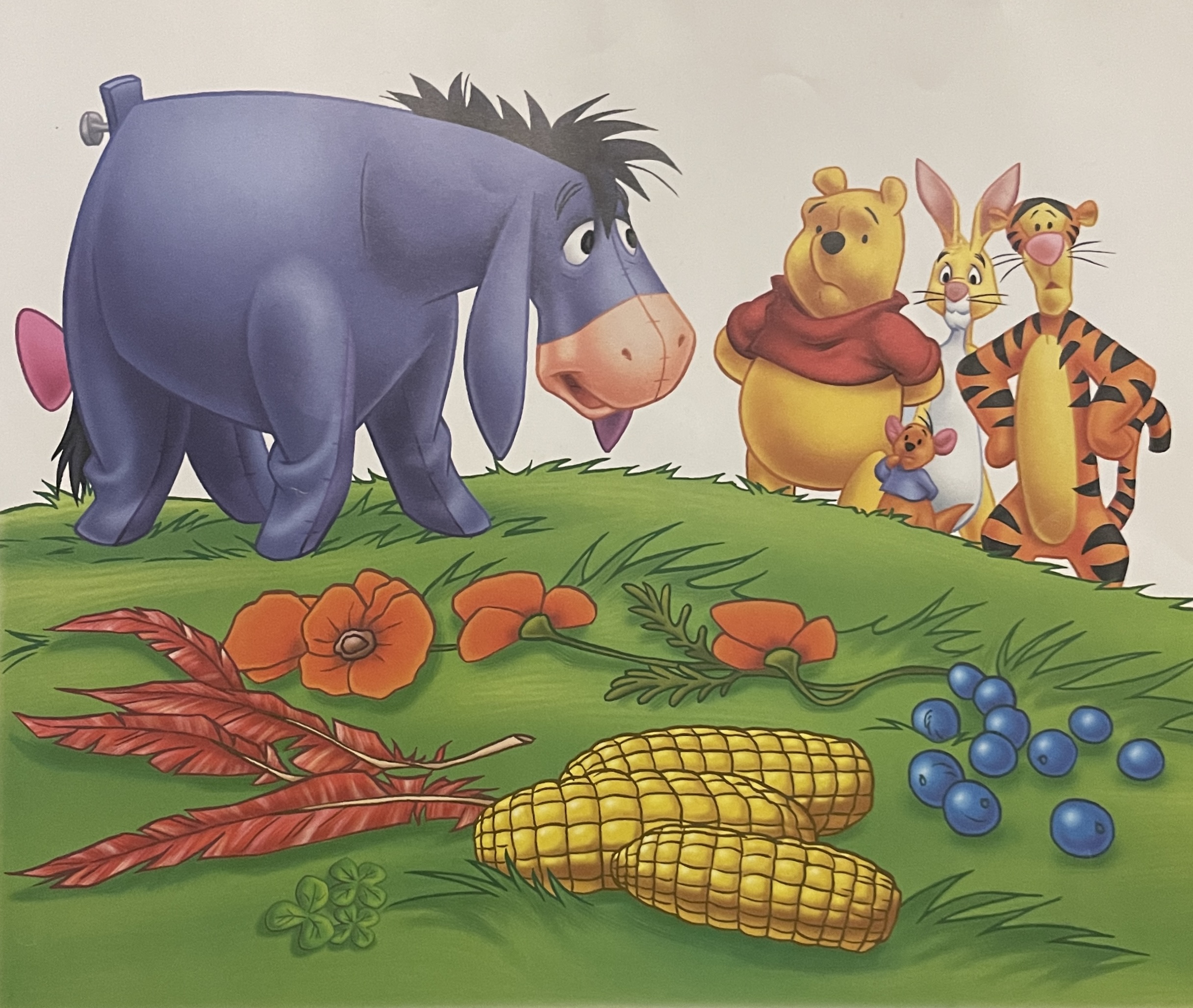
Many experiences that I had during my reading of these books were prompted by my own life, history, and values. Additionally, prior knowledge I had of Winnie the Pooh left me going into these books with a lot of expectations and previously conceived notions. I already decided that I identified with Eeyore before ever reading any Winnie the Pooh book. I went into these books already declaring that I would love them. While these are not bad things, they do influence the how much the quotes contribute to my experiences. Additionally, since these books are full of illustrations, the drawings add a lot to my experiences as well. Finally, since these are children’s books, they are quite short leading to minimal text to quote from. Nonetheless there were many experiences to be had and text that prompted them, it is simply necessary to keep in mind that I already went into these books happy.
The first joy I experienced (beyond the illustrations) was in how the story promoted the concept of Fika (a Swedish word meaning a moment to slow down and appreciate good things in life). Especially with the proliferation of technology, we often fail to recognize the beauty of nature. With the hustle and bustle of American culture, we also often fail to take breaks that are free of stress. I am abundantly guilty of this and practically chained to chairs with all of my jobs requiring me to sit at a desk, typically with my eyes glued to a computer screen. However, I love nature. I wish I spent more time appreciating the world as it was made for us, and this book starts promoting that value young. For me, this lesson allowed me to relearn, experience tranquility, and feel awe.
The rain had washed the trees and flowers, and they looked bright and fresh. And as the clouds parted, everything sparkled in the sun.
“Rainbow Colors” (Winnie the Pooh) – Cassandra Case (pg.3)
The Winnie the Pooh crew demonstrate great community and friendship, full of love and consideration. No one is to be left out and everyone is to be looked after and their happiness is to be ensured. Such values create a tranquil environment, inspiring connection and a sober uplift.
“Yes, yes, yes. You saw a rainbow,” said Owl.
“It’s a shame I missed it because I do enjoy rainbows,” Owl said a bit sadly.
And with that, he flew off feeling left out. The friends sensed a hint of sadness in Owl.
“Hey, fellas!” Said Tigger.
“What do ya say we go find some colory colorful things and bring ‘em back to Ol’ Beak Lips to cheer him up since he missed the rainbow?”
So the friends set out through the Wood, looking for colors all around.
And, indeed, there were colors everywhere: yellow ducks, green leaves, red birds, and purple butterflies!
“Rainbow Colors” (Winnie the Pooh) – Cassandra Case (pgs.10-12)
This community does feature one member who is more out of place than the others. Eeyore is a chronically sad individual, often thought of as a character symbolizing depression. Eeyore’s comments are often sad and his appearance is typically gloomy. His presence is a direct contrast from the rest of the colorful world and characters exuding endless joy. Despite his out of place color, thoughts, and actions, Eeyore fits in to the community thanks to its inclusion.
“I don’t know if anyone will notice,” said Eeyore.
But everyone did.
“Rainbow Colors” (Winnie the Pooh) – Cassandra Case (pg. 17)
“Thanks for noticing me, Owl,” said Eeyore.
“Winnie the Pooh and the Missing Pots” – Betty Birney (pg. 8).
As someone with a pessimistic nature and struggles with sadness and anxiety, the crew’s acceptance of Eeyore inspires generous love, self-acceptance, and double-identification in addition to the typical empathy felt for struggling characters. Due to this strong connection to Eeyore, seeing him reassured/affirmed and happy inspires a sober uplift in me as well as some thinking “what if?” with my mind wandering (wondering what life would be like if everyone was so kind and understanding).
“Oh, Eeyore!” cried Pooh.
“Am I glad to see you!”
“You are?” Eeyore said in surprise.
“Yes I am!” Replied Pooh.
“A Bedtime Story for Pooh” – Barbara Layman (pg. 24)
Similar experiences were garnered for other characters who felt reassured and experienced belonging in the community. Even for characters I do not know much about and have no identification with, I was able to experience a sober uplift and generous love (likely due to my pre-existing joy). The stories of the Winnie the Pooh crew teach similar values, consistently emphasizing community/friendship, consideration, and affirmation.
“Hooray! Piglet saved the day!” cried Roo.
“I did?” said Piglet hopefully.
He’d always wanted to do that.
“Rainbow Colors” (Winnie the Pooh) – Cassandra Case (pg. 22)
Through the sense of community and consideration present in the Winnie the Pooh crew, there are abundant lessons on how different people can support and care for you. This is demonstrated thoroughly in “A Bedtime Story for Pooh” as Pooh goes to everyone he knows in search of a bedtime story so that he can sleep and subsequently have breakfast. Each person tries to help, and directs Pooh to someone else that may be better able to help him than they were. Pooh is grateful for all the help he can get, despite his exhaustion and many failed attempts to sleep. Pooh’s resilience and kindness allows the reader (in this case, me) to experience a reminder that I am ready to grow, that there is always progress to be made to be a better person and that being tired might not be an adequate excuse for a lack of kindness. Further, this plot allows me to relearn how friends/families can be a safe space, a caring home that takes some of the burden away.
“When I’m with Piglet, nothing is quite as bad as it seems,”
he (Winnie the Pooh) said
“A Bedtime Story for Pooh” – Barbara Layman (pg. 16)
In reading “Winnie the Pooh and The Missing Pots”, I had many of the same experiences as well as a few new ones. The overwhelming experience I had was amusement, which I was surprised to find was not on our experiences list. I also could not find an equivalent, so I pose amusement as an experiential term referring to blissful enjoyment; a child-like positive preoccupation with a story thanks to its positive impact.
Soon Tigger and Roo were bouncing through the Hundred-Acre Wood.
“Bet I can bounce twice as high as you can!” Said Roo, giggling.
“Tiggers can bounce twice as high as anybody!” Answered Tigger.
So Tigger and Roo began a bouncing contest, bouncing over rocks and fallen branches along the way.
When they reached the Trash Tree, Tigger and Roo were surprised to find that their pots had all disappeared.
“Winnie the Pooh and the Missing Pots” – Betty Birney (pg. 2)
Once Tigger and Roo realized that they had lost their pots and the sight of their mission, they returned to Kanga. What they did not know, however, is that the rest of the Winnie the Pooh crew was also on a mission- to find a use for their new found treasures (the pots). One by one each character found a pot and made it their own, allowing it to serve a meaningful purpose in their life.
“A present for me?” Said Pooh.
“And it’s not even my birthday. I could use this to keep honey in!” Pooh scratched his head. “Now all I need is some honey.”
“Winnie the Pooh and the Missing Pots” – Betty Birney (pg. 4)
Rabbit bent over and picked up a battered tin pot.
“Did I grow this? He wondered.
Then he had a bright idea.
“This is just what I’ve been looking for,” he said, filling the pot with dirt and transplanting one of his prized carrots.
“Now I can keep my favorite carrot plant right in my house!”“Winnie the Pooh and the Missing Pots” – Betty Birney (pg. 6)
Owl swooped down to the ground. There, among the purple thistles, were two battered tin pots.
“This is a rare and ancient treasure, probably from long ago,” said Owl, proudly shining up one of the pots.
“And everyone who visits my house will admire it!”“Winnie the Pooh and the Missing Pots” – Betty Birney (pg. 8)
Eeyore also shined up his pot.
“So that’s what I look like,” he said, seeing his reflection in the pot.
“This is just what I needed— a mirror. Now I can make sure that my tail is still attached”
“Winnie the Pooh and the Missing Pots” – Betty Birney (pg. 9)
Piglet was outside sweeping when he discovered one of the tin pots near his house.
“I have so much cleaning to do today,” said Piglet, filling the pot with soapsuds.“This will really be a big help.”
And he happily began to scrub“Winnie the Pooh and the Missing Pots” – Betty Birney (pg. 10)

Piglet’s experience with his pot specifically had a lesson additional to the main parable of the tale. Piglet’s excitement and willingness to clean promotes the idea of cleaning as fun and encourages the prioritization of completing chores to young children. Another lesson is found in the story’s true, overarching meaning as Kanga advises against littering:
“Now you two must go back and look for them. We don’t want to litter the Hundred-Acre Wood.”
“Winnie the Pooh and the Missing Pots” – Betty Birney (pg. 11)
As Tigger and Roo venture through the forest, they cannot find the pots as they no longer perceive them as pots!
“Just Eeyore looking in a mirror,” answered Tigger.
“Winnie the Pooh and the Missing Pots” – Betty Birney (pg. 12)
“…we’re looking for a bunch of old pots we lost,” said Tiger.
“Oh,” replied Owl, disappointed. “Well, if you ever want to see a rare and ancient treasure, please feel free to call on me.”
“Winnie the Pooh and the Missing Pots” – Betty Birney (pg. 13)
…All Rabbit wanted to talk about was his new planter.
“Winnie the Pooh and the Missing Pots” – Betty Birney (pg. 14)
“I don’t have any old pots. But I do have a new pot Would you like to borrow it?” asked Piglet.
“Winnie the Pooh and the Missing Pots” – Betty Birney (pg. 15)
“Oh, bother,” said Pooh.
“I found this pot outside my house and I filled it with honey, buy now it’s empty again.”“Winnie the Pooh and the Missing Pots” – Betty Birney (pg. 16)
Once Pooh identifies his own pot as a pot indeed, Tigger and Roo realize that every member of the Winnie the Pooh crew had one of Kanga’s pots, they had just repurposed it. They run along to tell Kanga of their discovery, and she is happily surprised.
“And for the future, before we get rid of something, let’s see if we can find another use for it— or give it to someone else who can.”
“Winnie the Pooh and the Missing Pots” – Betty Birney (pg. 18) 
The story promotes the concepts of reduce, reuse, and recycle and shows that different things can have different values to those leading different lives. Overall, the story is very pleasant, entertaining, and meaningful.
“Tigger Tales” had a less clear purpose, with patience being the most evident concept promoted throughout the first story.
“Excuse me a moment, but there’s something climbing up your table,” and with one loud worraworraworraworraworra he jumped at the end of the tablecloth, pulled it to the ground, wrapped himself up in it three times, rolled to the other end of the room, and, after a terrible struggle, got his head into daylight again, and said cheerfully: “Have I won?”
“That’s my tablecloth,” said Pooh, as he began to unwind Tigger.
“I wondered what it was,” said Tigger.
“It goes on the table and you put things on it.”
“Then why did it try to bite me when I wasn’t looking?”
“I don’t think it did,” said Pooh.“It tried,” said Tigger, “but I was too quick for it.”
Pooh put the tablecloth back on the table, and he put a large honey-pot on the cloth, and they sat down to breakfast. As soon as they sat down, Tigger took a large mouthful of honey… and he looked up at the ceiling with his head on one side, and made exploring noises with his tongue and considering noises, and what-have-we-got-here noises.. and then he said in a very decided voice:
“Tiggers don’t like honey.”
“Oh!” Said Pooh, and tired to make it sound Sad and Regretful. “I thought they liked everything.”
“Everything except honey,” said Tigger.Pooh felt rather pleased about this, and said that, as soon as he had finished his own breakfast, he would take Tigger round to see Piglet’s house, and Tigger could try some of Piglet’s haycorns.
“Thank you, Pooh,” said Tigger, “because haycorns is really what Tiggers like best.”
“Tigger Tales” – A. A. Milne (pg. 3).
Despite Tigger’s destructive and likely irritating behavior, Pooh remains calm and simply undoes the harm caused. Pooh goes on to explain so that Tigger can grow an understanding and avoid making such mistakes in the future. Pooh never appeared angry and even offered to assist Tigger in his adventure to get breakfast, demonstrating care and promoting values of patience, understanding, and compassion. Even as Tigger goes on to reject numerous foods, Pooh stays determined to find something that Tigger can enjoy eating. On the way, Pooh also demonstrates consideration for Piglet.

So after breakfast they went round to see Piglet, and Pooh explained as they went that Piglet was a Very Small Animal who didn’t like bouncing, and asked Tigger not to be too Bouncy just at first. And Tigger, who had been hiding behind trees and jumping out on Pooh’s shadow when it wasn’t looking, said that Tiggers were only bouncy before breakfast, and that as soon as they had had a few haycorns they became Quiet and Refined.
“Tigger Tales” – A. A. Milne (pg. 4).
The saddest part of this tale, and the root of my existential nausea, lies in Eyesore’s response to giving up his birthday gift to himself in order to feed Tigger.
“A little patch I was keeping for my birth-day,” he said; “but, after all, what are birthdays?
Here today and gone tomorrow. Help yourself, Tigger.”
“Tigger Tales” – A. A. Milne (pg. 7).
I similarly am not a fan of birthdays and struggle with the concept of celebrating them, furthering my double identification and empathy with Eeyore. That, however, is where my experiences for this story and for the other two stories in “Tigger Tales” end. The only other experience of note is being wrong since I anticipated enjoying these stories far more than I truly did. I found a minor sober uplift in the emphasis on reassurance by Piglet, but that was short lived.
Piglet took Pooh’s arm, in case Pooh was frightened.
“Tigger Tales” – A. A. Milne (pg. 20).
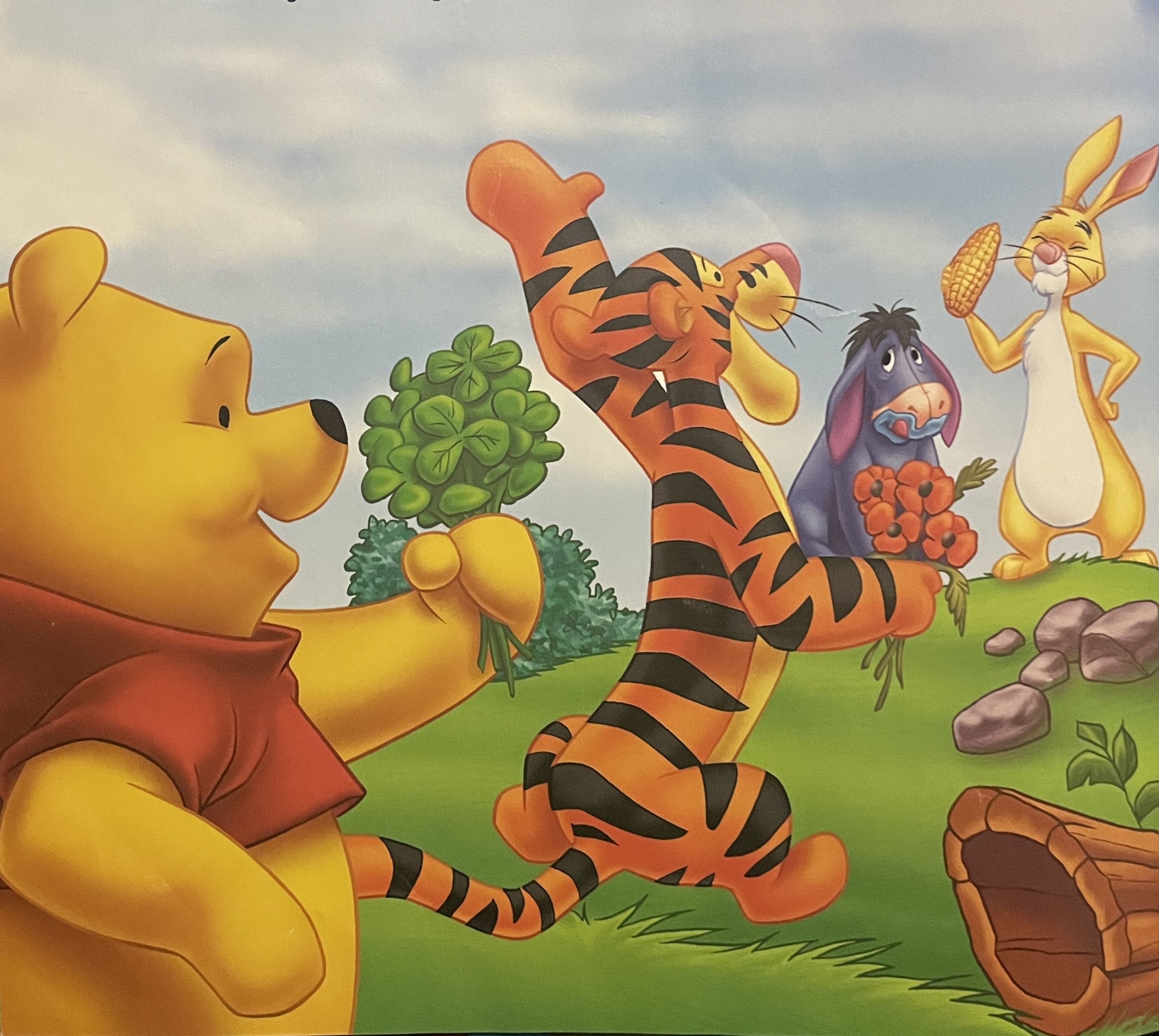 Attempting to Identify Technologies
Attempting to Identify Technologies
These stories, despite their brevity, contain substantial sophisticated, thoughtful technologies. These stories are epic similes by nature, taking animals and portraying them as we would humans (experiencing complex emotions, thoughts, and bonds/relationships). Despite the fact that the story is surely an enigma (these animals could not get along in the real world, and likely do not experience these same emotions/thoughts/relationships as humans do), these stories still act as powerful parables. These reality shifting stories offer opportunities to observe that pivot into positive emotions, utilizing a made up world to inspire joy and teach values. Every story of the Winnie the Pooh crew ends with wish fulfillment, allowing a guaranteed positive experience with nuggets of truth (values) along the way. No matter the story, there is always wish fulfillment which provides reassurance and joy for the reader.
“Rainbow Colors” specifically utilizes a gratitude booster, pointing out the beauties of the world in order to inspire peace, appreciation, and joy.
 Eeyore as a character acts as a shame reducer, exemplifying a stigmatized trait (pessimism)/mental illness (depression) without judgement or hate. Further, Eeyore is often portrayed in a sympathetic light. None of the Winnie the Pooh crew have a problem with Eeyore and rather reassure him often, voicing their appreciation of him or simply noticing his presence (which goes a long way with him). Nonetheless, Eeyore still acts as an empathy generator due to his sad comments and gloomy personality.
Eeyore as a character acts as a shame reducer, exemplifying a stigmatized trait (pessimism)/mental illness (depression) without judgement or hate. Further, Eeyore is often portrayed in a sympathetic light. None of the Winnie the Pooh crew have a problem with Eeyore and rather reassure him often, voicing their appreciation of him or simply noticing his presence (which goes a long way with him). Nonetheless, Eeyore still acts as an empathy generator due to his sad comments and gloomy personality.
Works Cited
Experiences Glossary – Story & The Brain. https://unewhavendh.org/story-and-the-brain/experiences-glossary/ . Accessed 10 Feb. 2025.
Technologies by Element of Narrative – Story & The Brain. https://unewhavendh.org/story-and-the-brain/technologies-by-element-of-narrative/. Accessed 10 Feb. 2025.
Case, Cassandra. “A Bedtime Story for Pooh”. https://www.goodreads.com/book/show/10404854-a-bedtime-story-for-pooh. Accessed 17 Mar. 2025.
Layman, Barbara. “Rainbow Colors”. https://www.thriftbooks.com/w/rainbow-colors—winnie-the-pooh-its-fun-to-learn-colors-volume-10_walt-disney-company/1620929/?srsltid=AfmBOoo95qHI5lYm0Kb2gCd5_l3JbxZhcptB5FN5vu5y6j6kDPxXR1oH#edition=3621874&idiq=28438464. Accessed 17 Mar. 2025.
Featured Image
Back cover of A Bedtime Story for Pooh. Scholastic. All rights Reserved.
